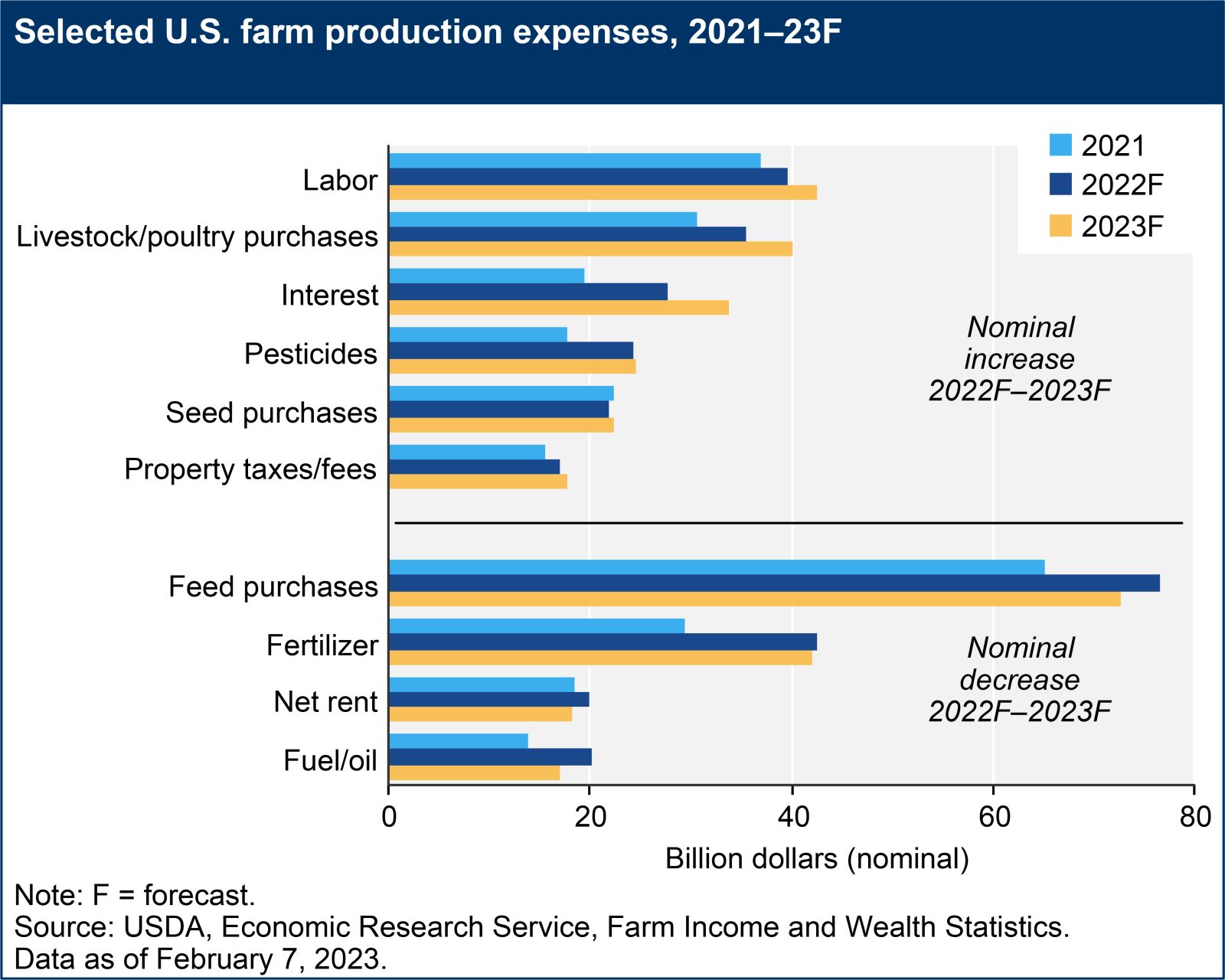Farm sector income is forecast to fall in 2023 following two years of strong growth. Net farm income, a broad measure of profits, is forecast to decrease by $25.9 billion (15.9 percent) from 2022 to $136.9 billion in calendar year 2023.
This expected decrease follows an annual increase of $46.5 billion (49.2 percent) in 2021 and a forecast increase of $21.9 billion (15.5 percent) in 2022. Net cash farm income is forecast to decrease by $39.4 billion (20.7 percent) from 2022 to $150.6 billion in 2023, after an annual increase of $32.7 billion (28.0 percent) in 2021 and a forecast increase of $40.4 billion (27.0 percent) in 2022.
In inflation-adjusted dollars, net farm income is forecast to decrease by $30.5 billion (18.2 percent) in 2023 and net cash farm income is forecast to decrease by $44.7 billion (22.9 percent) compared with the previous year. If realized, both income measures would remain above their 2020 level and 2002-2021 average (in inflation-adjusted dollars).
See a summary of the forecasts in the table U.S. farm sector financial indicators, 2016–2023F, or see all data tables on farm income and wealth statistics.
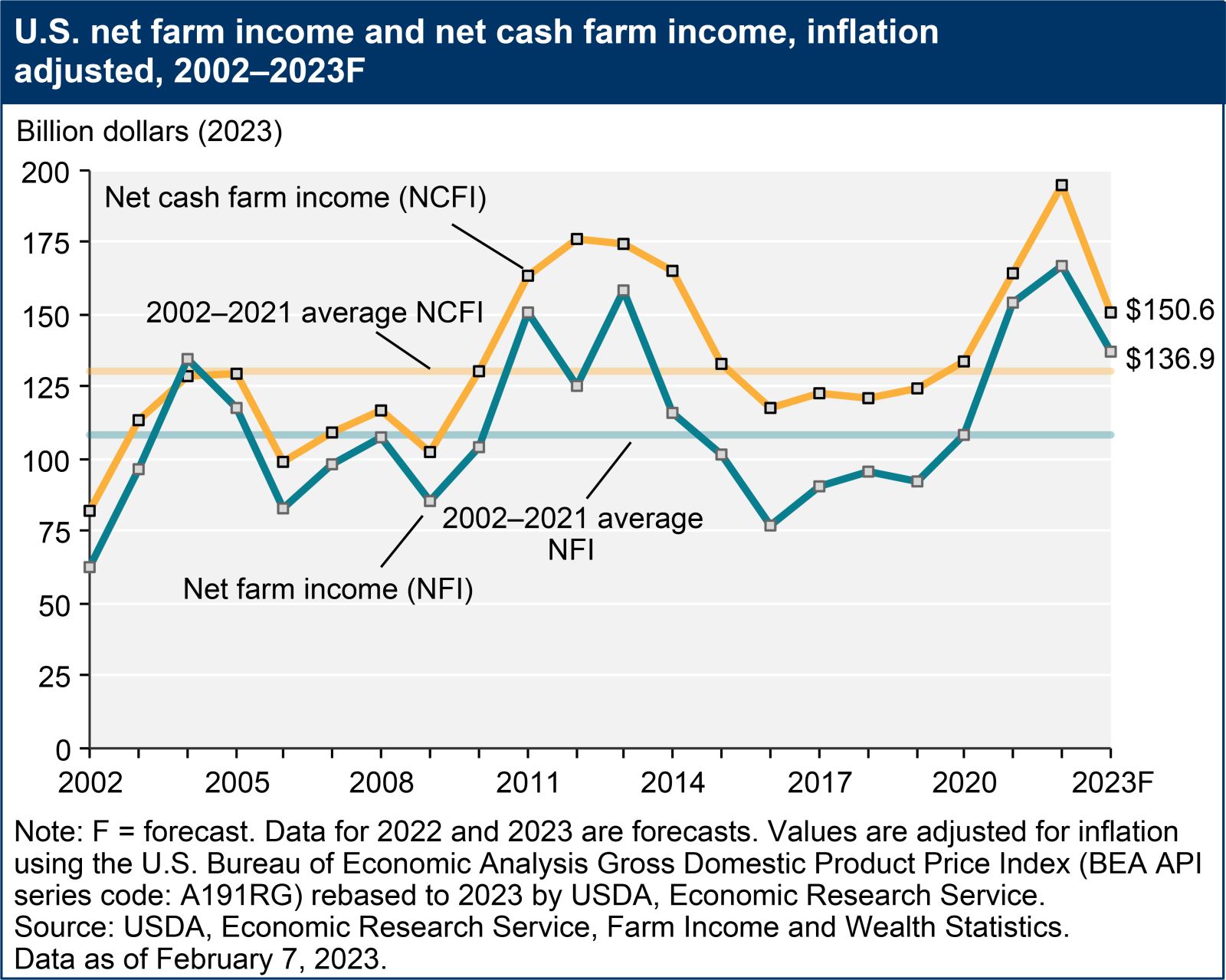
Note: In the text below, year-to-year changes in the major aggregate components of farm income are discussed only in nominal dollars unless the direction of the change is reversed when looking at the component in inflation-adjusted dollars.
Summary Findings
- Overall, farm cash receipts are forecast to decrease by $23.6 billion (4.3 percent) from 2022 to $519.9 billion in 2023 in nominal dollars. Total crop receipts are forecast to decrease by $8.9 billion (3.1 percent) from 2022 levels to $276.9 billion. Receipts for soybeans and corn are forecast to decrease while receipts for wheat and hay are forecast to increase. Total animal/animal product receipts are expected to decrease by $14.7 billion (5.7 percent) to $243.0 billion, following declines in receipts for milk, eggs, broilers, and hogs.
- Direct Government farm payments are forecast at $10.2 billion in 2023, a $5.4 billion (34.4 percent) decrease from 2022 levels. Direct Government farm payments include Federal farm program payments paid directly to farmers and ranchers but exclude U.S. Department of Agriculture (USDA) loans and insurance indemnity payments made by the Federal Crop Insurance Corporation. Much of this decline is because of lower supplemental and ad hoc disaster assistance to farmers and ranchers compared with 2022.
- Total production expenses, including those associated with operator dwellings, are forecast to increase by $18.2 billion (4.1 percent) in 2023 to $459.5 billion. Interest expenses and livestock/poultry purchases are expected to increase in 2023 while spending on feed and fuels/oils is expected to decline relative to 2022.
- Farm sector equity is expected to increase by 5 percent in 2023 to $3.5 trillion in nominal terms. Farm sector assets are forecast to increase 5.2 percent in 2023 to $4.0 trillion following expected increases in the value of farm real estate assets. Farm sector debt is forecast to increase 6.2 percent in 2023 to $535.1 billion. Debt-to-asset levels for the sector are forecast to worsen from 13.09 percent in 2022 to 13.22 percent in 2023. After increasing in 2021 and 2022, working capital is forecast to fall 11.2 percent in 2023 relative to 2022.
Receipts For Many Crops Forecast To Decline In 2023
Crop cash receipts are forecast at $276.9 billion in 2023, a decrease of $8.9 billion (3.1 percent) from 2022 in nominal terms. This forecast includes expected drops in corn, soybean, and vegetable and melon receipts, while wheat receipts are projected to grow during the year.
Corn receipts are forecast to fall by $4.1 billion (4.5 percent), as higher quantities sold are not expected to offset lower expected prices. Falling prices are also forecast to outweigh positive quantity effects for cotton receipts in 2023, resulting in a decline of $0.2 billion (2.1 percent). Soybean receipts are expected to decline $5.2 billion (8.1 percent), mainly due to lower forecasted prices. Expected growth in quantities sold should result in a gain in wheat receipts; they are forecast $0.6 billion (4.0 percent) higher in 2022. Hay receipts are expected to grow by $0.6 billion (6.1 percent) during the year, due to forecasted growth in both prices and quantities sold.
Vegetable and melon cash receipts are expected to decline $1.9 billion (8.7 percent) in 2023, driven by lower expected prices. However, this total includes a rise of $0.3 billion (7.5 percent) in potato receipts. Cash receipts for fruits and nuts are expected to fall $0.1 billion (0.4 percent) in 2023.
See data on value of crop production (in the value added table) and crop cash receipts.
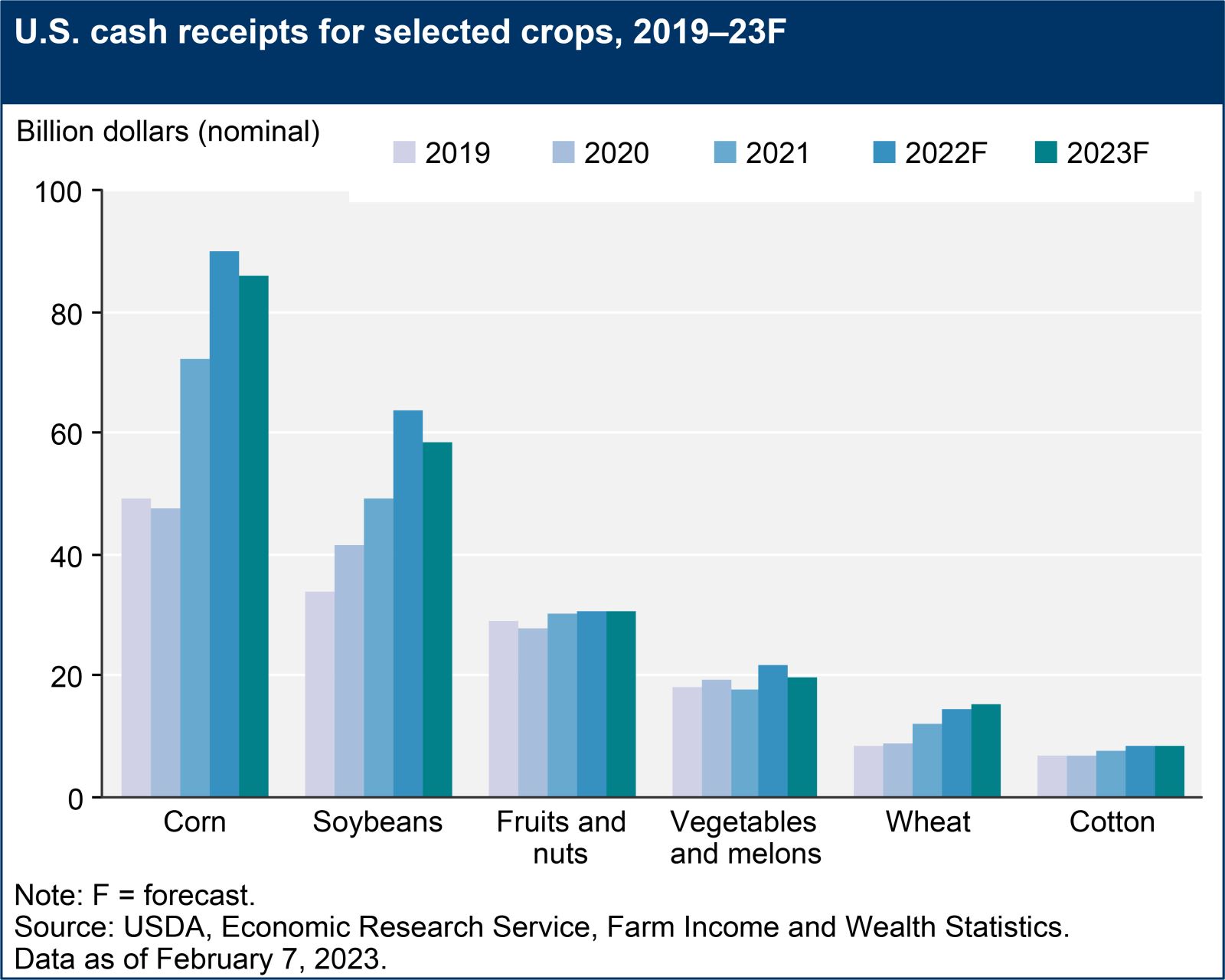
Falling Animal/Animal Product Receipts Forecast For 2023
Total animal/animal product cash receipts are expected to decrease $14.7 billion (5.7 percent in nominal terms) to $243 billion in 2023. Declining receipts are forecast for milk, hogs, broilers, and chicken eggs while cattle receipts are forecast to increase.
Milk receipts are expected to decrease $8.4 billion (14.6 percent) in 2023, due to falling prices. Hog receipts are forecast to decline by $0.8 billion (2.7 percent), as flagging prices should outweigh higher quantities sold. Conversely, higher prices are forecast to lead receipts for cattle and calves higher by $2.1 billion (2.4 percent) during the year, despite lower quantities sold.
Broiler receipts are expected to fall $3.6 billion (7.4 percent) in 2023, as falling prices should outweigh a positive quantity effect. Similarly, a large drop in prices should outweigh higher quantities sold for chicken egg receipts, which are forecast to fall $4.9 billion (24.0 percent). Receipts for turkeys are forecast to increase $0.7 billion (10.6 percent), behind expectations for higher prices and quantities sold.
See data on value of animal/product production (in the value added table) and animal/product cash receipts.
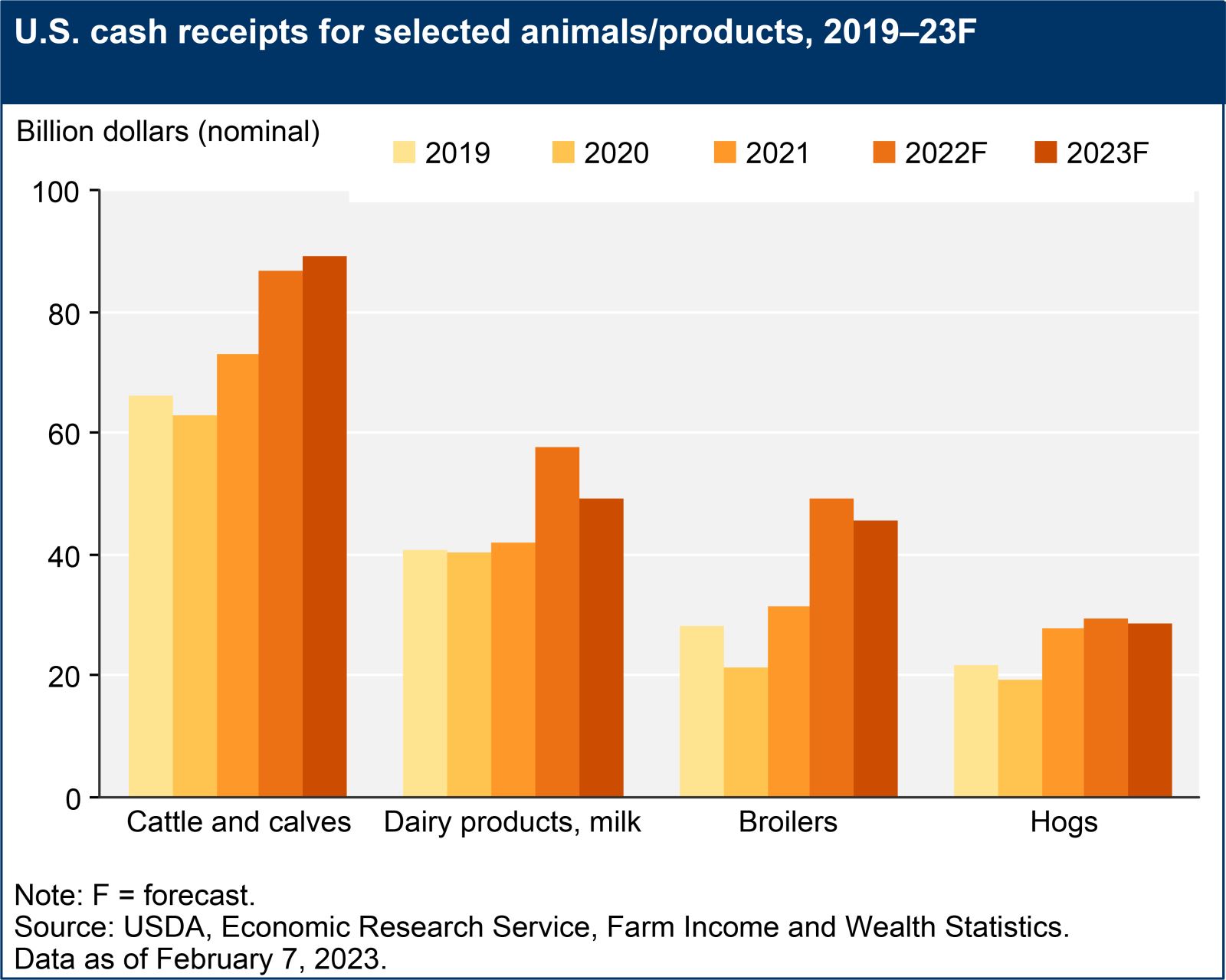
Lower Prices Drive Decline In Cash Receipts In 2023
To better understand the factors underlying the forecast change in annual receipts from 2022 to 2023, we decompose the change into two separate effects:
- a "price effect" where we project the change in cash receipts associated with holding the quantity sold constant at 2022 levels and allowing prices to change to forecast 2023 levels; and,
- a "quantity effect" where prices are held constant from 2022 and quantities change to forecast 2023 levels.
In 2023, falling prices are expected to account for most of the decline in cash receipts. Overall, cash receipts are forecast to decrease $23.6 billion in 2023, with an estimated negative price effect of $24.2 billion, and a projected negative quantity effect of $0.2 billion. In addition, an upward shift of $0.9 billion is from forecasts for commodities whose price and quantity effects cannot be separately determined. Price effects and quantity effects on cash receipts for livestock commodities are both forecast to be negative. Quantity effects on cash receipts for crops are positive, but price effects are negative.
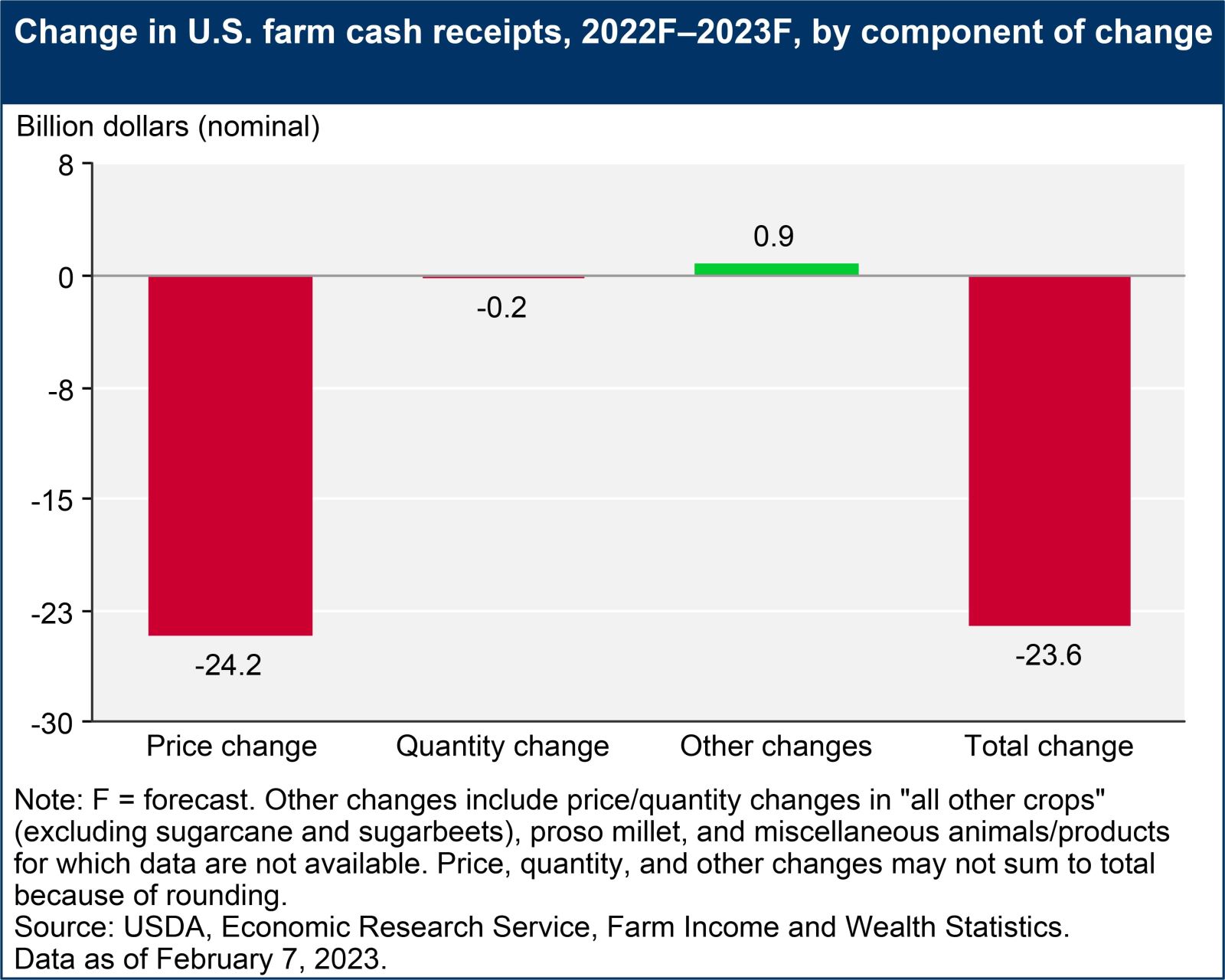
Direct Government Farm Payments Forecast To Decrease In 2023
Direct Government farm program payments are those made by the Federal Government directly to farmers and ranchers with no intermediaries. Typically, most direct payments to farmers and ranchers are administered by the USDA under the Farm Bill or other authorities.
Direct payments can also be from supplemental programs authorized by Congress. Government payments do not include Federal Crop Insurance Corporation (FCIC) indemnity payments (listed as a separate component of farm income) and USDA loans (listed as a liability in the farm sector’s balance sheet). After reaching a record high of $45.6 billion in calendar year 2020, direct Government farm program payments decreased to $25.9 billion in 2021. They are forecast to decrease further to $15.6 billion and $10.2 billion in 2022 and 2023, respectively. The overall decrease from 2020 in direct Government farm program payments reflects (primarily) lower anticipated payments from supplemental and ad hoc disaster assistance, including lower COVID-19 assistance.
- Supplemental and ad hoc disaster assistance payments in 2023 are forecast at $5.9 billion, a decrease of $5.7 billion (49.2 percent) from 2022, primarily because of lower payments from other supplemental and ad hoc disaster assistance programs. Lower payments are expected from the Emergency Relief Program (ERP) and the Emergency Livestock Relief Program (ELRP) created through the Extending Government Funding and Delivering Emergency Assistance Act.
- USDA pandemic assistance for producers, including from the Coronavirus Food Assistance Program (CFAP), provides relief to producers whose operations are directly affected by the COVID-19 pandemic. Payments in calendar year 2023 from these USDA programs are forecast at $983.5 million compared with $540.3 million and $7.5 billion in 2022 and 2021, respectively.
- Non-USDA pandemic assistance—payments from the Paycheck Protection Program (PPP), administered by the Small Business Administration (SBA)—ended on May 31, 2021, and no payments are expected in 2022 and 2023. Non-USDA pandemic assistance is estimated at $8.6 billion for 2021, based on January 8, 2023, data from the SBA. The PPP payments were designed to help small businesses keep their workers on the payroll through forgivable loans. Forgiven loan amounts are treated as a direct payment to farm operations.
- Other supplemental and ad hoc disaster assistance, which includes farm bill designated disaster programs, are forecast to be $4.9 billion in 2023, a decrease of $6.1 billion from 2022. This is largely because of lower expected payments from the Emergency Relief Program (ERP) and the Emergency Livestock Relief Program (ELRP).
- Conservation payments from the financial assistance programs of USDA's Farm Service Agency (FSA) and Natural Resources Conservation Service (NRCS) are expected to be $4 billion in 2023, up $462.1 million (or 13 percent) from the 2022 forecast amount. The increase in conservation payments is due to a marginal increase in Conservation Reserve Program (CRP) enrolled acres, an increase in payments from NRCS programs, and some expected payments from the Inflation Reduction Act (IRA) funds allocated for USDA’s conservation programs.
- The Dairy Margin Coverage Program (DMC) is forecast to make $285 million in payments in 2023 up by $156.7 million (122.2 percent) from the 2022 forecast. Some payments were first triggered in August 2022, because of a drop in milk prices that are forecast to fall further in 2023.
- Farm bill commodity payments under the Agriculture Risk Coverage (ARC) and Price Loss Coverage (PLC) programs are forecast to decline by $303.4 million, or 81.4 percent, in 2023 to $69.1 million. ARC payments are expected to be $41.1 million in 2023, a decrease of $64.0 million (60.9 percent) from 2022 levels. PLC payments in 2023 are expected be $28.0 million, a decrease of $239.4 million (or 89.5 percent) from 2022 levels. ARC payments are expected to decrease in 2023 because of higher commodity prices for all covered commodities, especially corn and soybeans, in 2022. PLC payments are also expected to decrease in 2023 because of higher prices for all covered commodities in 2022 compared with 2021.
See data table on Government payments.
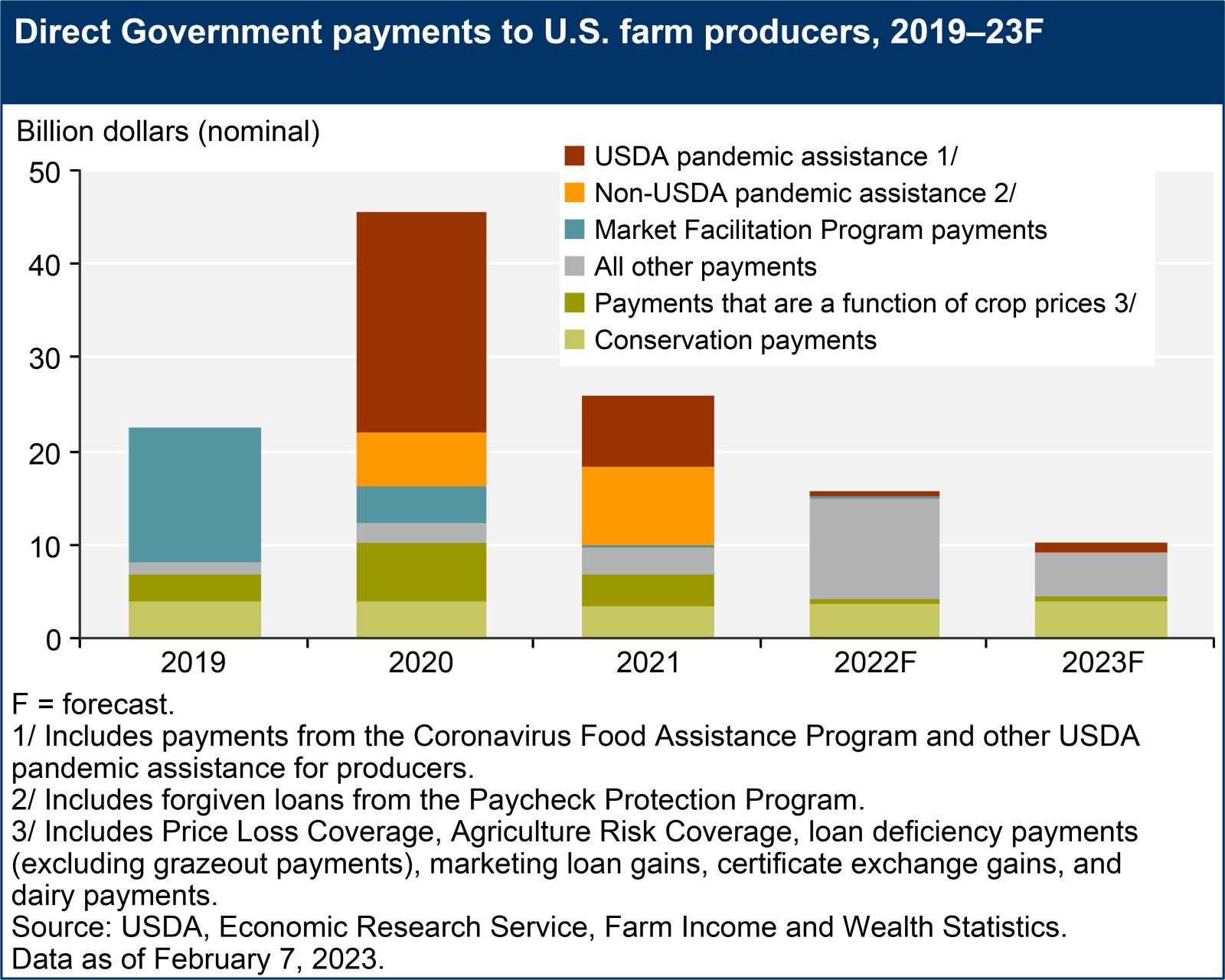
Production Expenses Forecast To Increase In 2023
Farm sector production expenses—including expenses associated with operator dwellings—are forecast to increase by $18.2 billion (4.1 percent) from 2022 to reach $459.5 billion in calendar year 2023. When adjusted for inflation, production expenses are forecast to increase by 1.3 percent from 2022 to 2023, remaining below the record-high level of 2014.
See data tables on production expenses.
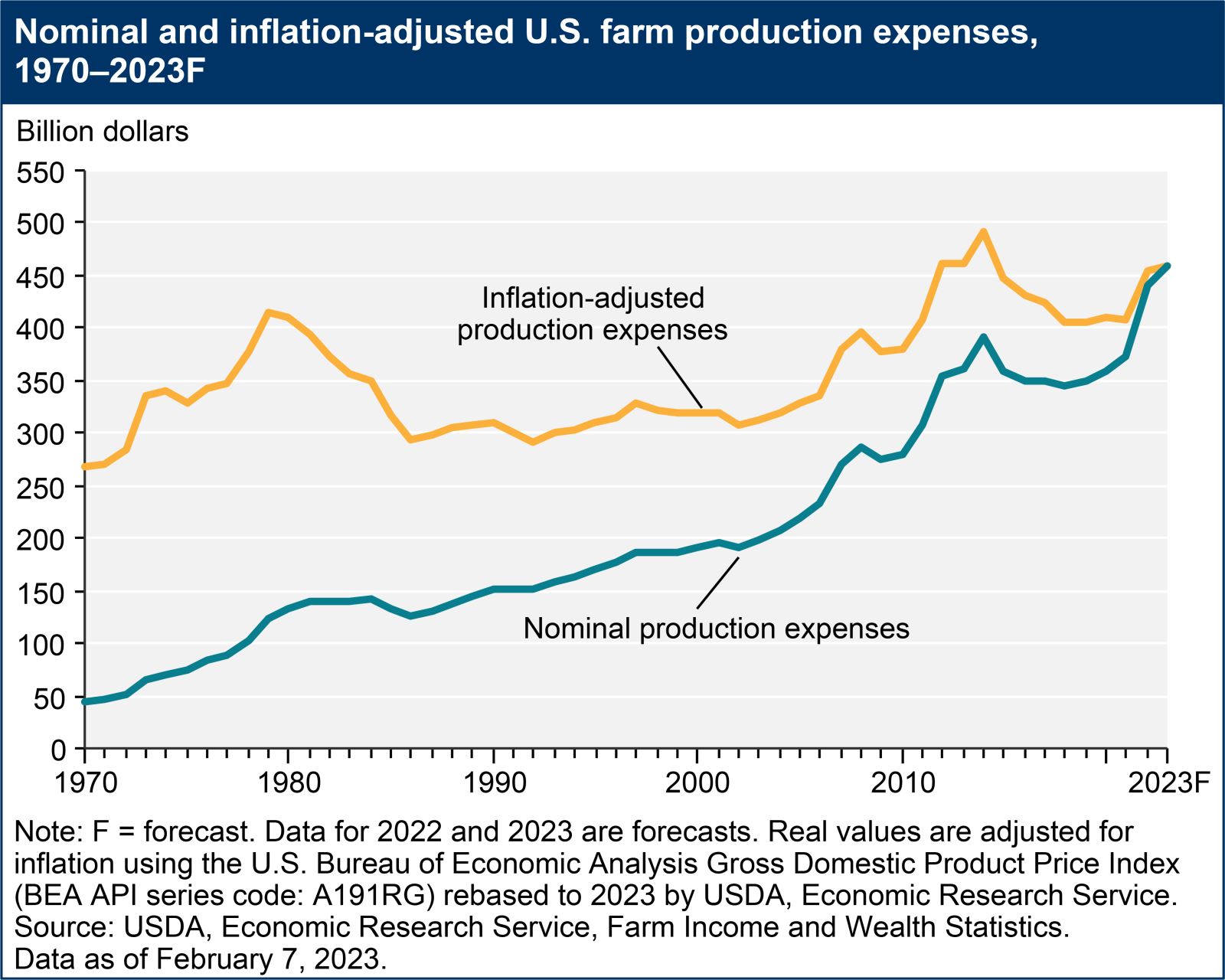
Most of the production expense categories are projected to remain above their 2021 levels in 2023, in both nominal and inflation-adjusted dollars. Feed expenses, the largest single expense category, are forecast at $72.7 billion in 2023, falling $3.9 billion (5.1 percent) from 2022. This reduction, however, follows a projected $11.3 billion (17.4 percent) increase in 2022. When adjusted for inflation, both 2022 and 2023 feed expense levels remain high but below the peaks of 2012–14. Fertilizer-lime-soil conditioner expenses, the second largest category, are forecast to have reached a record high in 2022 at $42.5 billion. They are expected to remain high at $42.2 billion in 2023, decreasing by $0.3 billion (or 0.8 percent) as compared with 2022.
Several expense categories are forecast to continue to increase in 2023, following considerable increases in 2022, with the most significant increases in nominal terms for the following categories:
- Interest expenses (including operator dwellings) are forecast to rise by $6.2 billion (22.4 percent) to $33.8 billion in 2023 following a projected increase of $8.2 billion (42.1 percent) in 2022. This reflects expectations that debt levels for the sector and interest rates will continue to grow in 2023, although at a slower rate than in 2022.
- Livestock and poultry expenses are forecast to rise by $4.8 billion (or 13.6 percent) to $40.2 billion. This increase is comparable to that experienced in 2022, when livestock and poultry expenses grew by $4.7 billion (15.4 percent), without adjusting for inflation.
- Labor expenses (including noncash employee compensations) are forecast to rise by $2.9 billion (or 7.3 percent), reaching $42.5 billion. When adjusted for inflation, labor expenses are expected to grow by 4.4 percent, after being staggered in 2022.
In addition to feed and fertilizer expenses, two other major expense categories are projected to decline in 2023:
- Fuel and oil expenses are projected to fall by $3 billion (14.9 percent) to $17.1 billion in 2023. The 2023 forecast is driven in part by the U.S. Energy Information Agency's forecast of lower diesel prices (by 80 cents per gallon, on average) in 2023. When adjusted for inflation, the 2023 level of fuel and oil expenses is forecast to match the 20-year average.
- Net rent is forecast to fall by $1.6 billion, or 8.2 percent, to $18.2 billion in 2023. If realized, this decline would be the first reduction in net rent since 2018 and, in part, reflects the forecast decline in net income.
Two major expense categories are forecast to increase in nominal dollars but fall when projected inflation is considered. These are seed expenses (increasing in nominal terms by $0.5 billion but shrinking by $0.1 billion in real terms) and pesticides (increasing by $0.2 billion in nominal dollars but shrinking by $0.5 billion reduction in real dollars).
